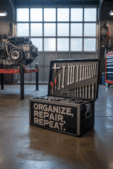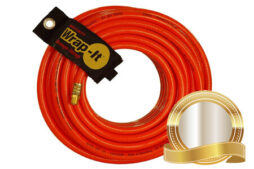The Anarchist Tool Chest: Where Rebellion Meets Really Nice DovetailsOh, hello there, fellow woodworking enthusiast (or curious onlooker wondering what on earth anarchism has to do with tool storage)! Today we’re diving into the world of the anarchist tool chest—which, spoiler alert, is much more than just a fancy box for your chisels. It’s practically a wooden manifesto with hinges! This beautiful rebel of the workshop world embodies a whole philosophy about craftsmanship, self-sufficiency, and telling consumerism to take a hike. So grab your favorite beverage, get comfortable, and let’s explore why so many woodworkers are joining this delightfully subversive wooden box revolution!The Rich History of Traditional Tool StoragePicture this: It’s the 18th century, you’re a traveling woodworker with a magnificent mustache (probably), and you need to haul your precious tools from job to job without them turning into a jumbled mess of expensive metal. What do you do? You build yourself a thoughtfully designed chest!These weren’t just random boxes—they were meticulously organized portable workshops where every tool had its perfect little home. These clever woodworkers weren’t following some IKEA-style instruction manual; they were solving real problems through years of Hmm, that didn’t work and Aha! That’s better! moments.Fast forward through a couple centuries of industrial revolution, plastic fantastic tool organizers, and power tool explosions, and we arrive at our modern woodworking landscape—complete with endless advertisements telling you that you absolutely NEED that specialized doohickey with seventeen attachments or you’ll never be a real woodworker.Christopher Schwarz: The Visionary Behind the MovementJust when things were getting a bit ridiculous in the tool-collecting department, along came Christopher Schwarz, former editor at Popular Woodworking Magazine, who basically looked around and said, Wait a minute, do we really need ALL this stuff?After diving deep into historical woodworking methods (like, submarine-level deep), Schwarz emerged in 2011 with The Anarchist’s Tool Chest—a book that’s part woodworking guide, part philosophical treatise, and part gentle intervention for your tool-hoarding tendencies.Schwarz’s book struck a chord with woodworkers everywhere who secretly suspected that maybe—just maybe—they didn’t actually need seventeen different types of specialty planes to build a nice table. His approach sparked a hand-tool renaissance that has thousands of woodworkers blowing dust off old hand planes and rediscovering the joy of making perfect shavings.And yes, if you’ve never experienced the satisfaction of a perfect hand plane shaving curling up like butter, you are missing out on one of life’s great pleasures!Design Excellence: What Makes This Chest ExtraordinaryThe anarchist tool chest isn’t just thrown together with some random boards and a prayer—it’s engineered with centuries-proven design principles that just work: Protection: It guards your precious tools like a wooden bodyguard, keeping moisture, dust, and that one friend who borrows tools and returns them rusty at bay. Accessibility: Frequently used tools live in the penthouse suites (upper tills), while the specialty tools that you use twice a year have basement apartments. Mobility: Despite being roughly the size of a small coffee table, it can actually be moved without requiring a team of oxen, thanks to clever skids and handles. Durability: Built with joinery techniques that laugh in the face of modern glued particle board. We’re talking generational furniture here—as in, Your great-grandkids will be fighting over this. Simplicity: No unnecessary flourishes or fancy bits (unless you want them). It’s the woodworking equivalent of a perfectly tailored suit—elegant because it fits its purpose perfectly. Capacity: Somehow manages to fit every tool you actually need without becoming a black hole of disorganization.Together, these features create a tool chest that’s not just practical but also a statement piece that says, I take my craft seriously, but I don’t take tool marketing seriously.The Anarchist Philosophy: More Than Just Tool StorageNow, before you start worrying that building this chest might put you on some watchlist, let me clarify the anarchist part. We’re not talking about throwing molotov cocktails here (though a poorly planned glue-up can sometimes feel like chaos has been unleashed in your workshop).The anarchism in this context is about freedom from the tyranny of consumerism and the relentless cycle of buy-use-discard-repeat that dominates modern tool culture.This woodworking philosophy is built on some revolutionary principles: Being self-sufficient enough to build rather than just buy Buying tools based on what you actually need, not what the latest catalog suggests you can’t live without Breaking free from the planned obsolescence trap by using tools that can last centuries Connecting with the long, rich tradition of people making beautiful things with simple tools Rejecting the idea that newer always equals betterIt’s about focusing on skill development rather than tool acquisition—a radical concept in our there’s an app for that world! By limiting yourself to what fits in the chest, you’re making a conscious choice to master what you have instead of constantly chasing the next shiny object.Essential Tools: Curating Your Perfect CollectionNow for the fun part—filling your chest with beautiful tools that don’t need batteries or power cords! The anarchist approach suggests a carefully curated collection of high-quality hand tools that can tackle virtually any woodworking task.Think of it as assembling your woodworking dream team, where every player has multiple skills and there are no benchwarmers.Measuring and Marking Tools 6-inch precision steel rule (for when measurements actually matter) 12-inch precision rule (for when they matter but are bigger) Marking gauge (for making lines way straighter than you could freehand after coffee) Marking knife (because pencil lines are for amateurs—kidding, sort of) Dividers (perfect for laying out proportions or playing tiny music on your workbench) Try square (to check if things are square and to remind you that they probably aren’t) Combination square (the Swiss Army knife of layout tools)Sawing Tools Rip saw (cuts along the grain and through your preconceptions about how much sawdust you can create) Crosscut saw (cuts across the grain with teeth so sharp they could probably cut through your excuses for not finishing projects) Dovetail saw (for those joints that impress everyone at parties—yes, we have different parties than most people) Tenon saw (because mortise and tenon joints have only been working perfectly for thousands of years) Coping or fret saw (for curves and interior cuts that make people ask, How did you do that?)Hand Planes Jack plane (the workhorse that turns lumpy boards into less-lumpy boards) Jointer plane (makes edges straight enough to make a mathematician swoon) Smoothing plane (creates surfaces so smooth you’ll want to pet them—go ahead, I won’t judge) Block plane (small but mighty, especially on end grain) Router plane (nothing to do with the power tool—this creates consistent depth grooves by hand) Rabbet plane (for edge joinery that fits together like a dream)With this collection, you can build practically anything—furniture, cabinets, toys, or even another tool chest! It’s like the woodworking equivalent of a capsule wardrobe—everything works together, nothing is superfluous, and you always look good using it.Breaking the Tool Addiction: Finding Freedom in EnoughLet’s have a heart-to-heart moment here. How many tools in your workshop have you used… never? Or maybe once three years ago?We’ve all been there—standing in the store (or browsing online at 2 AM), convinced that this specialized gadget will FINALLY make us the woodworker we’ve always wanted to be. Schwarz brilliantly points out that this tool accumulation often becomes a substitute for actually, you know, making things.The problems with tool hoarding are real: Your workshop starts to look like a tool museum where nothing can be found when needed Your wallet weeps quietly in the corner while you explain that you needed another plane You spend more time researching and organizing tools than using them (guilty as charged!) You become dependent on specialized tools rather than developing skills to work around limitations Planet Earth side-eyes you for all that manufacturing and shipping impactThe chest creates a physical boundary that says, Enough. If it doesn’t fit, you probably don’t need it. This limitation isn’t restrictive—it’s liberating! Suddenly you’re focusing on mastering what you have rather than constantly hunting for the next tool.Building Your Own Anarchist Tool Chest: Materials and DimensionsReady to join the revolution? Let’s talk about building your very own anarchist tool chest! Traditionally, these chests are made from eastern white pine—not because it’s fancy, but because it’s practical: lightweight, stable, readily available, and won’t break the bank.Of course, you can use whatever wood makes your heart sing (or whatever you can find on sale).Size-wise, we’re looking at something roughly: Length: 36-40 inches (enough to fit those lovely hand saws without folding them, which they strongly object to) Width: 20-24 inches (roomy enough for tools but not so wide you need a passport to get to the other side) Height: 20-24 inches (tall enough for storage but not so tall you need mountaineering equipment to reach the bottom)These dimensions create a chest that’s substantial but not ridiculous. It’s like the Goldilocks of tool storage—just right!For materials, you’ll want to gather: Lumber: 1-inch thick boards for most parts, with slightly thicker pieces (1.25-1.5 inches) for structural elements that need to be extra sturdy Hardware: Traditional iron or brass hinges, carrying handles that won’t give up when you lift the chest, and maybe a lock if your tools are particularly attractive to others Fasteners: Cut nails for authenticity and excellent holding power (plus they look awesome) Finish: Milk paint or oil-based paint for traditional protection and a patina that actually looks better as it ages (unlike most of us)Timeless Joinery: Connections That Last GenerationsNow for the fun part—putting it all together with joinery techniques that have stood the test of time (and will probably outlast most relationships): Dovetail joints: Those interlocking triangular marvels that join the corners and look impressive enough to make non-woodworkers gasp. They’re the structural equivalent of a firm handshake agreement—they simply don’t let go. Dado joints: Grooves cut into the sides that cradle the bottom panel like it’s precious cargo—which it is, considering it’ll be supporting the weight of your entire tool collection. Rabbet joints: These L-shaped cuts create perfect meeting places for various components, including the all-important dust seal that keeps your tools from becoming archaeological artifacts. Nailed construction: Some parts are traditionally attached with cut nails, which look old-school cool and hold like they’re afraid of unemployment.Learning these joinery techniques isn’t just about building a chest—it’s about connecting with centuries of craftsmanship. Each dovetail you cut links you to generations of woodworkers who solved the same problems with similar solutions, just without YouTube tutorials to help them!Finishing Touches: Protection With CharacterYour beautiful new tool chest deserves a finish that protects it from workshop hazards while developing character over time. Traditionally, these chests weren’t left as natural wood—they were painted for practical protection: Milk paint: This old-school finish creates a textured, matte appearance that ages like fine wine. Plus, it’s so non-toxic you could technically drink it (please don’t—it tastes terrible, or so I’ve heard…) Oil-based paint: Provides bombproof moisture protection and a traditional look that says, I’m serious about my woodworking but not above a little decoration. Interior finishing: The inside typically remains unfinished or lightly oiled—no sense in having your tools slip-sliding around on glossy surfaces, and the raw wood helps regulate humidity. Wax application: A final coat of wax makes everything work smoothly and gives a subtle sheen that feels amazing under your hands. It’s like moisturizer for your woodwork!Traditional colors like Prussian blue, barn red, and forest green connect your chest to historical practices, but there’s no anarchist color police—paint it hot pink with flames if that makes you happy! (Actually, that would look pretty awesome…)Internal Organization: A Symphony of StorageThe internal organization of an anarchist tool chest is like a beautifully choreographed dance where every tool knows its steps: Sliding till layers: Usually two or three trays at the top that slide back and forth, revealing different sections like the world’s most practical magic trick. These hold smaller tools you reach for constantly. Main compartment: The basement level where larger tools live, often separated by dividers to prevent them from having territorial disputes. Tool racks: The underside of the lid becomes valuable real estate with racks for hanging saws, squares, and other flat tools—like a tiny tool cityscape hanging upside down. Plane storage: Bench planes rest on their sides to protect their delicate cutting edges—they’re basically taking a nap until you need them. Saw till: A diagonal rack keeps your saws accessible without risking damage to their teeth (dental work for saws is expensive and rarely covered by insurance).This organization becomes second nature over time. You’ll develop a woodworker’s muscle memory, reaching for tools without even looking—very impressive during demonstrations and a good way to pretend you’re more organized than you actually are in other areas of life.Making It Your Own: Personal Touches for Your ChestWhile the traditional design has proven itself over centuries, there’s no reason not to add your personal touch. After all, what’s more anarchist than breaking a few rules? Consider these custom options: Size adjustments: Building a smaller version because your workshop is more cozy than spacious? Go for it! The tool chest police won’t come knocking. Interior configuration: Arrange your tills to fit YOUR tools, not some historical woodworker’s collection. That specialty marking gauge you love deserves a custom-fitted home. Hardware selection: Traditional hardware is beautiful, but if modern hardware makes your heart flutter, use it! The functionality matters more than historical purity. Wood selection: Pine is traditional, but if you have access to another wood that works better for you, that’s fine! I’ve seen gorgeous chests in cherry, walnut, and even reclaimed barn wood. Decorative elements: Carving, inlay, painted designs—these personal touches make your chest uniquely yours while maintaining its core function.The key is maintaining the functionality while adapting to your specific needs. Your chest should work for you, not the other way around—it’s your loyal workshop companion, not your demanding boss!The Joy of Working Within Limits: Finding Freedom in ConstraintsThere’s a special kind of magic that happens when you embrace the limitations of a carefully selected tool set: You develop ninja-level skills with your tools because you use them consistently rather than jumping between seventeen variations of the same tool type. Your workflow becomes almost musical as you move efficiently between familiar tools that you can locate blindfolded. Your tools actually stay sharp and tuned because you have time to maintain a reasonable collection properly. Your workshop feels spacious and organized rather than like a tool hoarder’s intervention waiting to happen. Your wallet thanks you as you invest in fewer, better tools rather than a warehouse full of mediocre ones. Your problem-solving skills flourish as you figure out how to accomplish tasks with the tools you have rather than buying a new specialized tool for every situation.It’s like the difference between being a chef who can create amazing meals with basic ingredients versus one who needs seventeen specialized gadgets to make dinner. Both approaches work, but one makes you more adaptable and skilled!Join the Community: Resources for Your JourneyReady to dive deeper into this delightful woodworking rebellion? You’re not alone! A vibrant community awaits: Essential reading: Start with The Anarchist’s Tool Chest by Christopher Schwarz—the book that launched a thousand dovetails. His follow-ups The Anarchist’s Design Book and The Anarchist’s Workbench continue the philosophical journey. Online communities: The Lost Art Press blog, woodworking subreddits, and specialized Discord servers are full of like-minded folks sharing tips, celebrating victories, and commiserating over dovetail disasters. Hands-on learning: Many woodworking schools now offer classes specifically on building these chests—ideal if you learn better with someone guiding you through the process and preventing catastrophic errors. Video tutorials: YouTube is bursting with chest-building adventures, from professional productions to heartwarming I have no idea what I’m doing but I’m doing it anyway documentation. Tool sources: Specialty retailers can help you find the perfect tools to fill your chest, whether vintage or modern reproductions.The community around traditional woodworking is incredibly supportive and surprisingly un-judgmental. We’ve all split a dovetail, measured wrong, or dropped a chisel on our foot at some point—these shared experiences create bonds that transcend skill levels.The anarchist tool chest represents a joyful rebellion against disposable culture—a wooden declaration that you value craft, intention, and lasting quality. By building one, you’re not just creating a box for tools; you’re making a statement about how you choose to engage with woodworking and perhaps with life itself.Whether you’re a seasoned woodworker with decades of experience or just starting your journey, this project offers something profound: a tangible connection to generations of craftspeople who found satisfaction in creating beautiful, useful things with their hands. So pick up that saw, prepare those boards, and join the quiet revolution happening in workshops around the world. Your tools—and your future projects—will thank you!



















































